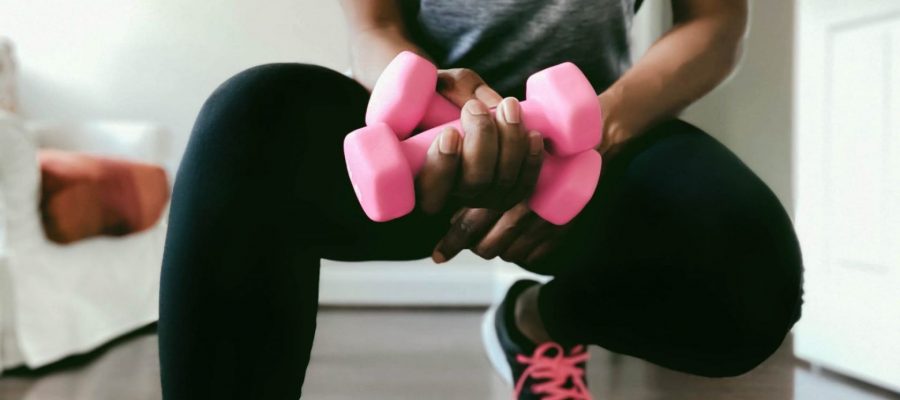Living with arthritis as a young person can be life-defining. But when writer Sarah Blake found out that her RA had led to permanent damage in her knees, she took up strength training – and she’s not looked back since.
On the face of it, my weekly Fitbit report seems pretty unremarkable: 10,000 daily steps, three or four resistance training sessions a week, and a cardio fitness score that’s where it should be for my age.
Yet every time that report hits my inbox, I’m reminded of two things: how lucky I am to be able to sustain this level of activity nearly four decades into a diagnosis of rheumatoid arthritis (RA), and how thankful I am to have ‘found’ resistance training.Lifting weights builds muscle; muscle protects my joints; protected joints mean, for me, a better quality of life for a longer period of time.
You may also like
Arthritis and exercise: four women on how they move with arthritis
I was diagnosed with rheumatoid arthritis 38 years ago, at the age of six. I spent eight weeks in hospital on total bed rest, followed by a decade of wearing splints on my right wrist and left leg. Aside from physio, exercise just wasn’t on the agenda.I was unable to participate in PE at school and felt totally disassociated from anything to do with sport.
As is typical of juvenile rheumatoid arthritis, the symptoms of my disease significantly lessened when I was in my mid-teens.I no longer needed to wear splints and was suddenly able to be more active.But exercise was utterly unfamiliar to me and I felt completely out of my depth.I tried it. I hated it.And so I completely avoided it.
Things changed in my 20s when I joined a gym and discovered the joys of the crosstrainer. I became a full-on cardio queen, exercising as a means to maintain my weight and never with my RA in mind.Yet, totally unintentionally, by getting fitter, I was slowing down the disease progression of my RA.
Whenever I’d go for appointments to see my rheumatologist, I’d sit in the waiting room feeling like I didn’t ‘belong’ there as I listened to other patients talk about their illness and realised that they were letting it totally define their lives. I didn’t feel like that at all. That’s not to say that RA didn’t, and doesn’t, impact my life in a big way.It’s more a case that I live with it and work around the symptoms. I can’t remember a time when I didn’t experience chronic, underlying pain, and I suffer from extreme exhaustion, which has had a hugely negative impact on my life, particularly on relationships, friendships, and work.

But it was only in my 30s that the reality of living with a degenerative illness really hit me. Up until that point, RA was something that I had but I’d never properly contemplated what it could mean for my future life. For the first time, I began to properly research the potential implications of my disease.
I was scared. And, in all honesty, I felt a real sense of hopelessness and lack of control; it felt like the future of my health was in the lap of the gods. I didn’t want to deal with the emotions, so I just carried on as normal. Bad flare-ups were relatively rare for me, which made it easier for me not to address the issue of the future worsening of my condition.
Then, in the second 2020 lockdown, things went a bit pear-shaped while I was home-exercising to a YouTube video. I ended up in excruciating pain and was unable to walk for a month. MRI scans confirmed that there is permanent damage to the cartilages in both of my knees – something I already knew but had never had confirmed. Both the physio and my rheumatologist told me that the most important thing I could do to prevent further damage, and slow the disease progression, was to build the muscles around all of my joints. In a nutshell, I needed to start resistance training.
You may also like
Yoga for back pain: “I tried these stretches every day for a month – and they’ve cured my chronic back ache”
I began to familarise myself with some of the gym equipment that I’d been avoiding for decades. But my attempts were sporadic and my motivation was low. I needed help. I signed up with one of the personal trainers at my gym and, for the first time in my life, I began working out with the goal of building muscle to make my future life better.Up until that point, exercise for me had been totally about the now.
I now work with a personal trainer three times a week and definitely wouldn’t be making the progress I am without their help and support. My rheumatologist is incredibly pleased and hopeful that the efforts I’m putting into resistance training, combined with biological immunosuppressants, will effectively slow the disease progression.I feel immensely lucky to be at the stage I’m at with this disease and to physically be able to take the steps I am to slow its progression.
What is rheumatoid arthritis?
Professor Namita Kumar, consultant rheumatologist at South Tyneside and Sunderland NHS FT, explains that there are lots of different types of arthritis, saying: “You can divide these into two major types: ‘wear and tear’ joint degeneration forms, such as osteoarthritis, or inflammatory conditions.”
The most common form of inflammatory arthritis is rheumatoid arthritis which, says Dr Kumar, “is part of a group of conditions that are autoimmune in origin, which means the body reacts to part of itself to cause the inflammation”. RA affects 1% of the UK population and is up to four times more common in women than in men.“RA onset can occur at any age”, says Namita, “but it peaks in people aged 30-50.”
How does resistance training help manage rheumatoid arthritis?
Ben Greenhalgh, personal trainer at Fitness Plus in Lancashire, explains that “weights and resistance training is vital for all body composition clients but especially those with RA. The strengthening of joints, tendons and muscles is pivotal for long-term health. Keeping clients mobile, stable and pain-free is always my first priority and therefore educating clients through safe and effective weight training is extremely effective in helping RA.”
Dr Kumar agrees: “It’s become really clear that exercise is very important for treatment of RA.Strong muscles around joints can protect them from further damage by supporting them as well as preventing future problems.”
If you have a diagnosis of RA, Dr Kumar stresses the importance of seeking advice from your GP or rheumatologist before starting any new exercise plan and enlisting the support of a qualified personal trainer if you want or more structured or intensive regime.
Greenhalgh adds: “It’s very important to avoid high impact, fast and/or explosive movements that will put unnecessary strain on the joints. Stable, tension-based weight training with a progressive overload structure is the most beneficial and useful form of training for sufferers of RA.”
Sarah’s full-body resistance training workout
Three sets of 8-12 reps with 60-90 seconds rest between each set:
- Leg press
- Hip thrust
- Lat pull down
- Goblet squat
- Chest press
- Seated low row
- Shoulder press
- Tricep extension
Looking to get strong? Check out our range of workouts, How-To videos and training plans.
Images: Getty/author’s own
Source: Read Full Article
